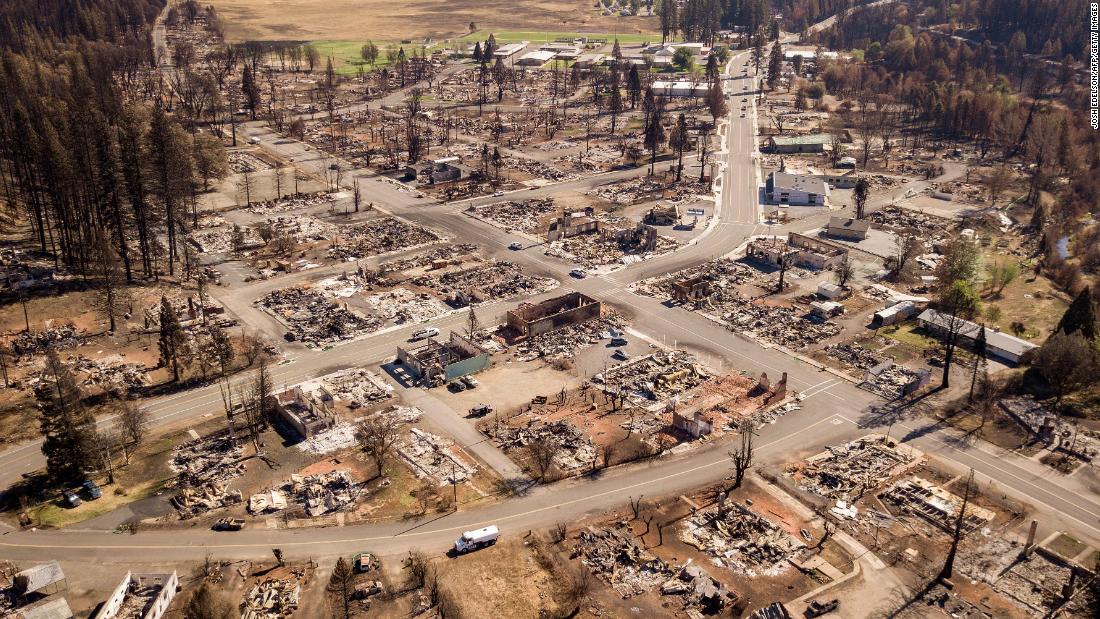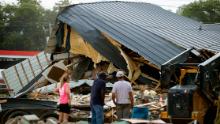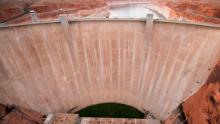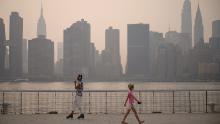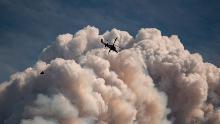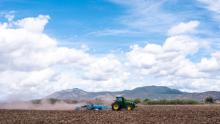“It was impossible to ignore climate change this summer,” Rachel Licker, a senior climate scientist with the Union of Concerned Scientists, told CNN. “And unfortunately, this isn’t a one-time thing … this is what we can expect more of, especially if we don’t get off fossil fuels and invest in measures to build our resilience as soon as possible.”
After months of deadly extremes, Americans’ feelings on the climate crisis has evolved dramatically. For the first time, a majority of Americans now believe that the US is facing the consequences of a warming world, according to a new poll from the Yale Program on Climate Change Communication.
Here’s what the US experienced this summer.
7. Hurricane Henri
Hurricane Henri, after weakening to a topical storm, flooded parts of the Northeast in late August with a deluge of rain from New Jersey to southern New England.
The storm set a new record for the most rain in a single hour in New York City — nearly two inches of rain fell in Central Park from 10 p.m. to 11 p.m. on August 21, according to the National Weather Service. Nearly 5 inches of rain fell in New York City the following day, which also set a record for the date.
Tens of thousands of homes were left without power across the Northeast, with more than 42,000 customers left powerless in Rhode Island alone.
Extreme rainfall rates are becoming more common because of human-caused climate change, scientists say. Scientists reported in August that “the frequency and intensity of heavy precipitation events have increased since the 1950s over most land area.”
6. Tennessee flash flooding
In the same week Hurricane Henri unleashed a torrent in the Northeast, a staggering amount of rain, unrelated to the hurricane, led to flash flooding in Tennessee that destroyed more than 270 homes and killed at least 21 people.
Among those killed were 7-month-old twins, according to the Humphreys County Emergency Management Agency. The twins were swept out of their father’s arms during the flood, a family member said.
State emergency-management officials were not prepared for the magnitude of the event. The downed phone lines, coupled with washed out roads, made it harder for them to get into the flood zone. One resident told CNN that even after seeking refuge on the highest room in her house, the water kept rising to the point that the bed she was on began to float.
She said she later called a police officer who urged her to get into the attic and break through to the roof.
5. Water shortage declared
While flooding tore through the East, a water shortage was declared in the West.
Plagued by extreme, climate change-fueled drought and increasing demand for water, the federal government in August declared a water shortage on the Colorado River for the first time, triggering mandatory water consumption cuts for states in the Southwest beginning in 2022.
Two of the nation’s largest reservoirs fed by the Colorado River — Lake Powell and Lake Mead — have been draining at alarming rates. California’s Lake Oroville dropped so low that the reservoir’s hydroelectric power plant was shut down for the first time since it opened in the 1960s.
Brad Udall, senior water and climate scientist at Colorado State University, told CNN that the West should prepare for more shortages as the climate crisis intensifies.
“Not only do we have to plan for these undesirable water outcomes, but we also have to get our act together and reduce greenhouse gases as fast as we can,” Udall said.
4. Bootleg, Dixie and Caldor Fires
A summer of record-breaking, triple-digit heat and severe drought fueled more than a hundred large wildfires in the West. The three largest fires of 2021 have burned roughly 1.6 million acres, an area half the size of Connecticut.
In July, the Bootleg Fire scorched more than 410,000 acres in southern Oregon, making it the second largest wildfire in the country this year.
At the same time, the Dixie Fire in California was slowly growing and later surpassed Bootleg as the largest fire in the US this year, charring nearly a million acres and making it the second largest fire in California history.
A few weeks later, the Caldor Fire torched its way through the El Dorado National Forest, and its smoke led to exceptionally poor air quality in Lake Tahoe in California and Reno, Nevada. It is now the third largest fire this year.
High-level winds also wafted smoke from the West’s wildfires across the country, stretching from the West Coast to New York City.
“It was shocking to me that huge tracts of the country spent weeks under air quality alerts from the large wildfires in the West and Canada,” Licker said. “No matter where you were, you couldn’t avoid climate change.”
3. The Pacific Northwest heatwave
Scientists say the unprecedented heatwave that killed hundreds the Pacific Northwest and British Columbia in late June would have been “virtually impossible” without human-caused climate change.
Experts told CNN the normally temperate region is generally unprepared for extreme heat events. Hundreds of people died from heat-related illness in Oregon and Washington, while many visited emergency departments or urgent-care clinics.
Across the border in British Columbia, the same heat wave fueled a fast-moving wildfire that obliterated the town of Lytton just one day after the temperature soared to 121 degrees and broke Canada’s record.
Scientists say the punishing heat also cooked billions of shellfish alive.
This summer was the hottest on record in the US, tied with the Dust Bowl summer of 1936, according to the National Oceanic and Atmospheric Administration.
2. Hurricane Ida
In late August, Category 4 Hurricane Ida destroyed homes, uprooted trees and cut off power to more than 1 million residents in Mississippi and the already storm-ravaged state of Louisiana.
Ida checked all the boxes of how climate change is making hurricanes more dangerous, according to scientists: producing more rainfall, moving slower once they make landfall and generating larger storm surges along the coast.
As the storm made its way inland, Ida’s remnants triggered flash flood emergencies in the Northeast. The storm broke Henri’s single-hour rainfall record in Central Park and gave Newark its wettest day ever. The flooding killed at least 50 people in the region, many of whom drowned in basement apartments.
Scientists say storms like this will become more common as the planet warms. Hurricane Ida exposed the dire need to strengthen New York City’s infrastructure against the worsening climate crisis.
1. The West’s historic drought
Amid all the acute disasters, the Western US has been in the grips of a historic, multi-year drought, which scientists say is a clear sign of how the climate crisis is affecting not only the weather but water supply, food production and electricity generation.
More than 93% of the West is in drought this week, according to the US Drought Monitor, with six states entirely in drought status: California, Nevada, Oregon, Idaho, Utah and Montana.
In southern Oregon, the drying of the Klamath Basin exploded into a water war this year that has pitted local farmers against Native American tribes, government agencies and conservationists. It’s reflective of the dire situation engulfing the West.
The drought has “definitely made it a lot harder for us to get by year after year, and it’s making an already tight margin a lot tighter,” Tricia Hill, a 4th-generation farmer, told CNN in June. “For all of us, we’ve got families, employees, customers — people we have to figure out how to take care of.”
Scientists told CNN that the unrelenting drought is about to get worse with La Niña on the horizon, and that it could last into 2022 — or potentially longer.
